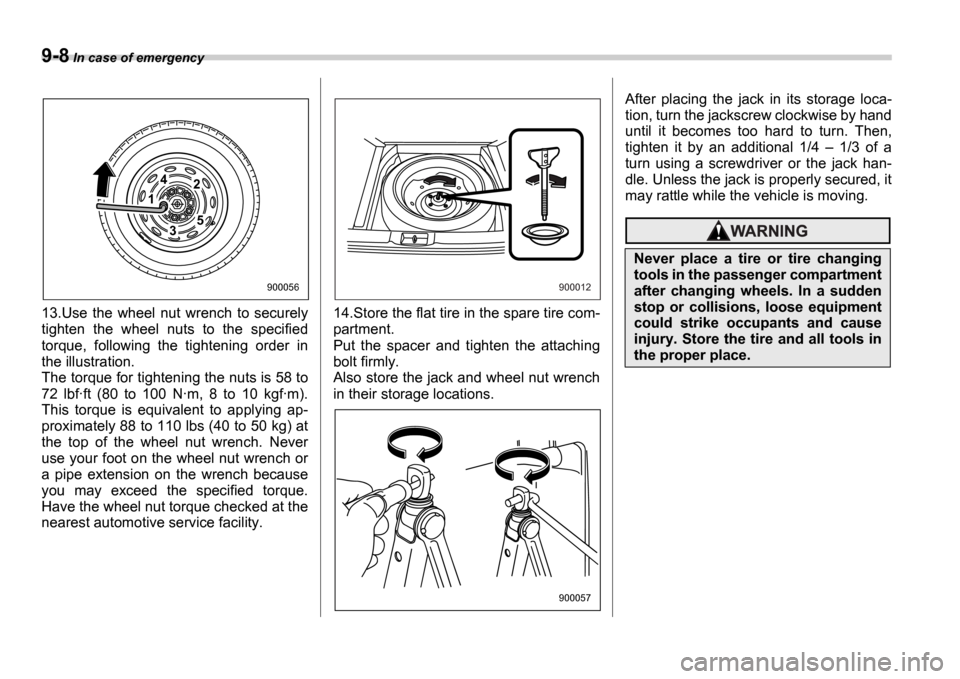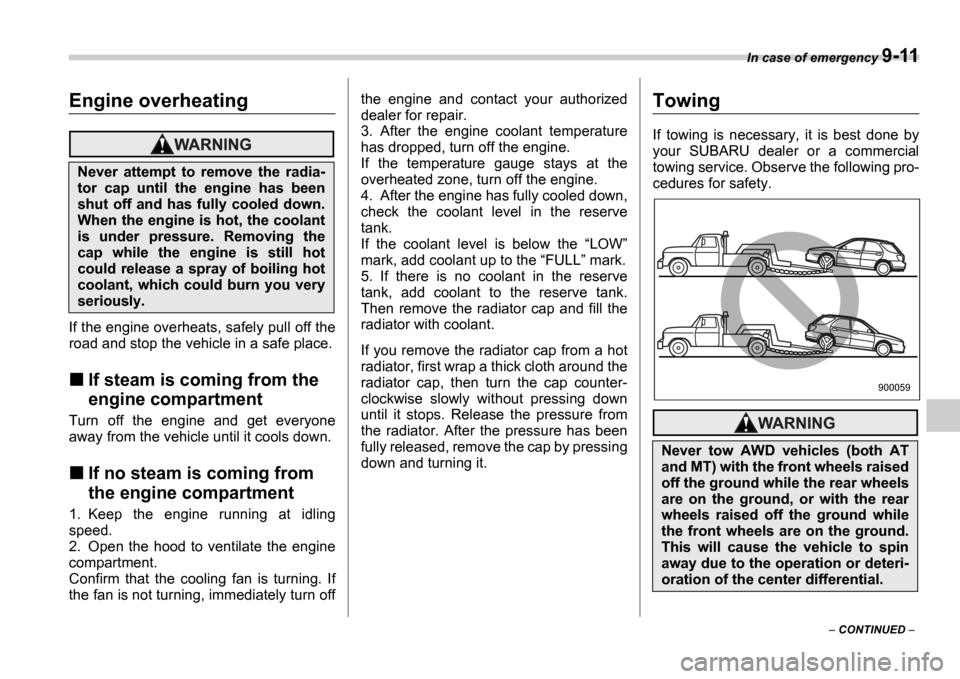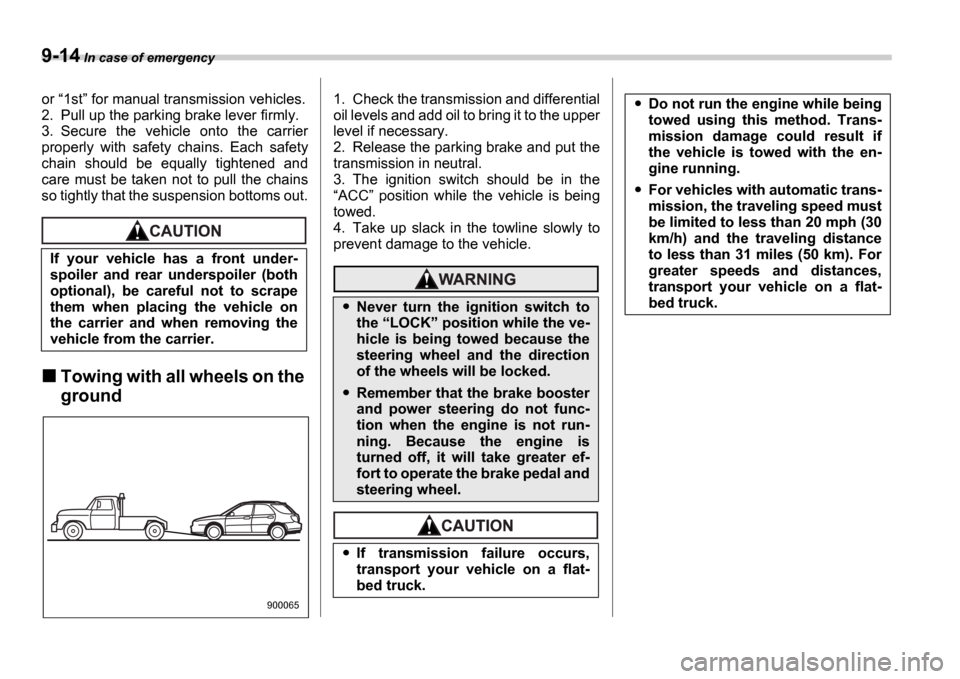Page 260 of 365
In case of emergency 9-5
CONTINUED
Wagon
1) Jack
2) Jack handle
3) Spare tire
5. Take out the spare tire, jack, and wheel
nut wrench.
The spare tire is stored under the floor of
the trunk or cargo area.
To remove the spare tire, proceed as fol-
lows: Sedan:
Remove the floor cover from the
trunk. Remove the storage compartment
(if so equipped).Turn the attaching bolt
counterclockwise, then take the spare tire
out.
Wagon: Open the lid.
Remove the storage compartment (if so
equipped). Turn the attaching bolt coun-
terclockwise, then take spare tire out.
If the spare tire provided in your vehicle is
a temporary spare tire, carefully read the
3
1
2
900268900047
900290
Page 261 of 365
9-6 In case of emergency
section Temporary spare tire in this
chapter and strictly follow the instructions.
The jack is stored on the left side of the
trunk or cargo area.
To take out the jack:
Remove the cover, turn the jackscrew counterclockwise to loosen it, then re-
move the jack.
If the jackscrew is too tight to be loosened
by hand, loosen it using a screwdriver or
the jack handle.
The jack handle is stored under the spare
tire cover.
NOTE
Make sure the jack is well lubricated
before using it.
6. Loosen the wheel nuts using the wheel
nut wrench but do not remove the nuts.
Jack-up points (Vehicle with side sill
skirt)
900049
900050
900269
900053
Page 262 of 365
In case of emergency 9-7
CONTINUED
Jack-up points (Others)
7. Place the jack under the side sill at the
front or rear jack-up point closest to the flat
tire.
Turn the jackscrew by hand until the jack
head engages firmly into the jack-up point. 8. Insert the jack handle into the jack-
screw, and turn the handle until the tire
clears the ground. Do not raise the vehicle
higher than necessary.
9. Remove the wheel nuts and the flat
tire.
10.Before putting the spare tire on, clean
the mounting surface of the wheel and
hub with a cloth.
11.Put on the spare tire. Replace the
wheel nuts. Tighten them by hand.
12.Turn the jack handle counterclockwise
to lower the vehicle.
900054900055
900009
Do not use oil or grease on the
wheel studs or nuts when the spare
tire is installed. This could cause the
nuts to become loose and lead to an
accident.
900073
Page 263 of 365

9-8 In case of emergency
13.Use the wheel nut wrench to securely
tighten the wheel nuts to the specified
torque, following the tightening order in
the illustration.
The torque for tightening the nuts is 58 to
72 lbf ∑ft (80 to 100 N ∑m, 8 to 10 kgf ∑m).
This torque is equivalent to applying ap-
proximately 88 to 110 lbs (40 to 50 kg) at
the top of the wheel nut wrench. Never
use your foot on the wheel nut wrench or
a pipe extension on the wrench because
you may exceed the specified torque.
Have the wheel nut torque checked at the
nearest automotive service facility. 14.Store the flat tire in the spare tire com-
partment.
Put the spacer and tighten the attaching
bolt firmly.
Also store the jack and wheel nut wrench
in their storage locations.After placing the jack in its storage loca-
tion, turn the jackscrew clockwise by hand
until it becomes too hard to turn. Then,
tighten it by an additional 1/4
1/3 of a
turn using a screwdriver or the jack han-
dle. Unless the jack is properly secured, it
may rattle while the vehicle is moving.
1
42
53
900056900012
900057
Never place a tire or tire changing
tools in the passenger compartment
after changing wheels. In a sudden
stop or collisions, loose equipment
could strike occupants and cause
injury. Store the tire and all tools in
the proper place.
Page 266 of 365

In case of emergency 9-11
CONTINUED
Engine overheating
If the engine overheats, safely pull off the
road and stop the vehicle in a safe place.
If steam is coming from the
engine compartment
Turn off the engine and get everyone
away from the vehicle until it cools down.
If no steam is coming from
the engine compartment
1. Keep the engine running at idling
speed.
2. Open the hood to ventilate the engine
compartment.
Confirm that the cooling fan is turning. If
the fan is not turning, immediately turn off the engine and contact your authorized
dealer for repair.
3. After the engine coolant temperature
has dropped, turn off the engine.
If the temperature gauge stays at the
overheated zone, turn off the engine.
4. After the engine has fully cooled down,
check the coolant level in the reserve
tank.
If the coolant level is below the
LOW
mark, add coolant up to the FULL mark.
5. If there is no coolant in the reserve
tank, add coolant to the reserve tank.
Then remove the radiator cap and fill the
radiator with coolant.
If you remove the radiator cap from a hot
radiator, first wrap a thick cloth around the
radiator cap, then turn the cap counter-
clockwise slowly without pressing down
until it stops. Release the pressure from
the radiator. After the pressure has been
fully released, remove the cap by pressing
down and turning it.
Towing
If towing is necessary, it is best done by
your SUBARU dealer or a commercial
towing service. Observe the following pro-
cedures for safety.
Never attempt to remove the radia-
tor cap until the engine has been
shut off and has fully cooled down.
When the engine is hot, the coolant
is under pressure. Removing the
cap while the engine is still hot
could release a spray of boiling hot
coolant, which could burn you very
seriously.
Never tow AWD vehicles (both AT
and MT) with the front wheels raised
off the ground while the rear wheels
are on the ground, or with the rear
wheels raised off the ground while
the front wheels are on the ground.
This will cause the vehicle to spin
away due to the operation or deteri-
oration of the center differential.
900059
Page 269 of 365

9-14 In case of emergency
or 1st for manual transmission vehicles.
2. Pull up the parking brake lever firmly.
3. Secure the vehicle onto the carrier
properly with safety chains. Each safety
chain should be equally tightened and
care must be taken not to pull the chains
so tightly that the suspension bottoms out.
Towing with all wheels on the
ground
1. Check the transmission and differential
oil levels and add oil to bring it to the upper
level if necessary.
2. Release the parking brake and put the
transmission in neutral.
3. The ignition switch should be in the ACC position while the vehicle is being
towed.
4. Take up slack in the towline slowly to
prevent damage to the vehicle.
If your vehicle has a front under-
spoiler and rear underspoiler (both
optional), be careful not to scrape
them when placing the vehicle on
the carrier and when removing the
vehicle from the carrier.
900065
Never turn the ignition switch to
the LOCK position while the ve-
hicle is being towed because the
steering wheel and the direction
of the wheels will be locked.
Remember that the brake booster
and power steering do not func-
tion when the engine is not run-
ning. Because the engine is
turned off, it will take greater ef-
fort to operate the brake pedal and
steering wheel.
If transmission failure occurs,
transport your vehicle on a flat-
bed truck.
Do not run the engine while being
towed using this method. Trans-
mission damage could result if
the vehicle is towed with the en-
gine running.
For vehicles with automatic trans-
mission, the traveling speed must
be limited to less than 20 mph (30
km/h) and the traveling distance
to less than 31 miles (50 km). For
greater speeds and distances,
transport your vehicle on a flat-
bed truck.
Page 271 of 365
9-16 In case of emergency
4. Insert the wrench in the end of the mo-
tor shaft.
To lower the moonroof, turn the wrench
clockwise.
To close the moonroof, turn the wrench
counterclockwise.
Have your vehicle checked and repaired
by an authorized SUBARU dealer.
Maintenance tools
Your vehicle is equipped with the following
maintenance tools:
Screwdriver
Towing hook (eye bolt)
Wheel nut wrench
Hex-headed wrench (vehicles with
moonroof)
Jack and jack handle
The jack is stored on the left side of the
trunk (Sedan) or cargo area (Wagon).
To take out the jack, turn the jackscrew
counterclockwise to loosen it, then re-
900069
900070
900049
Page 274 of 365
10
Appearance care
Exterior care ....................................................... 10-2
Washing ........................................... ........................ 10-2
Waxing and polishing .............................. ............... 10-3
Cleaning aluminum wheels .......................... .......... 10-3
Corrosion protection .............................. ............ 10-4
Most common causes of corrosion ................... ... 10-4
To help prevent corrosion ......................... ............ 10-4
Cleaning the interior ............................. ............. 10-5
Seat fabric ....................................... ........................ 10-5
Leather seat materials ............................ ................ 10-5
Synthetic leather upholstery ...................... ........... 10-5
Climate control panel, audio panel, instrument panel, console panel, and switches ............... ... 10-6